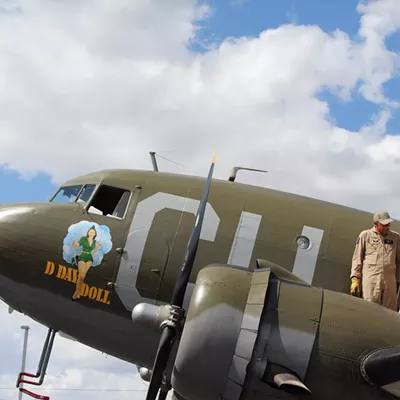But she wasn't just missing, a 6-year-old girl who happened to wander off. She'd been kidnapped, snatched from the sidewalk outside her school by someone an eyewitness said was a dirty, emaciated man wearing sunglasses.
This spectacular crime gripped Tucson like nothing before--or since.
Cops blocked every road into and out of town. Rescuers entered homes and literally turned over beds. The post office ordered every mailbox in town searched for ransom notes. Armed volunteers descended on potential hideouts across Southern Arizona and Mexico.
Then, suddenly, after 19 days of captivity, rescuers responding to a mysterious tip out of Chicago found little June in the desert near Broadway Boulevard and Wilmot Road and returned her, physically unharmed, to her family.
The case should've ended there, but how could it? Too many questions remained unanswered. Police never named any good suspects. No trial was held; no ransom was paid.
And as time wore on, the few hard facts that existed seemed to melt into a haze of innuendo and whispers. The story blurred so badly that more than two years after June's rescue, a grand jury investigation questioned whether a kidnapping had occurred at all.
June had just left the Roskruge School on Fifth Street, near Tucson High, around 3 p.m. on Wednesday, April 25. A beat-up Ford sedan pulled to the curb beside her. Eyewitness Marguerite Smith, who'd just picked up her son, saw the man inside beckon June into the backseat.
"The child seemed to be saying, 'No, no,' but the man seemed to be insisting," said Smith, who drove on, unwilling to intrude on what she thought might be a family matter.
The kidnapping's second act unfolded later that day on Church Street downtown. A man slipped 25 cents to a boy named Rosalio Estrada with instructions to deliver a note to June's father at Robles Electric Company.
Rosalio handed the note to Fernando Robles at 5 p.m. The kidnappers were demanding $15,000. The letter also included detailed instructions on how to deliver the money--and a threat to June's life if its contents were revealed.
Fernando penciled a fast reply and gave the note to Rosalio to deliver to the kidnapper. But when the boy returned to the parking lot, across from Robles Electric, the man had vanished.
News reports say Fernando feared bringing the cops in, but somehow they found out, and quickly. By nightfall, investigators had begun their work, and the clock on June's imprisonment had started ticking.
TUCSON IN 1934 WAS STILL a small desert town, neighborly and peaceful. But it was growing, too, and losing its cherished isolation from the troubles of the outside world.
Only three months before, police had captured notorious outlaw John Dillinger and his gang in Tucson. They'd rented a house in a quiet neighborhood on Second Avenue, posing as ordinary winter visitors.
But even after Dillinger, few believed Tucson's streets could hold men capable of taking an innocent girl from her family, threatening to kill her for money.
That changed overnight, and outrage fell over the city like a monsoon rain.
Heeding a call for help, volunteers streamed to the sheriff's office the morning after the kidnapping. News reports described "scores of aroused citizens milling angrily about." Within hours, some 400 men had signed on to help search every house in town.
Around noon on the 26th, the kidnappers delivered a second note, this one to Bernabe Robles, June's grandfather. It read:
"Mr. Robles. Child safe. We are willing to reduce the ransom to $10,000 if you act quickly. Child will be returned safely as per your instructions. Obey instructions. Signed Z."
The kidnappers' effort to involve Bernabe made it likely that he was the real target.
Reputed to be one of Southern Arizona's wealthiest men, Bernabe had come to the United States in 1864, at age 7, from Mexico. He and his mother reportedly crossed the border on burros, their possessions hanging over the animals' backs.
Bernabe and wife, Joaquina, eventually opened a store in Tucson, and they went on to amass a fortune in ranching and real estate, becoming one of the community's most prominent families. Robles Junction, west of Tucson, is named for them.
The local papers jumped on the Bernabe Robles angle. They dubbed him a "cattle baron," and a "stately, keen-eyed Spanish aristocrat," and June became an "heiress."
Reporters also were quick to note her blood tie to Assistant County Attorney Carlos Robles, June's uncle and Fernando's twin brother.
Carlos secured an airplane to swoop over the desert in what was being called "the greatest manhunt ever staged in the West."
The massive publicity produced 100 telephone tips to police the first five days.
The result was a circus that had cops plunging into abandoned mineshafts and even scouring Colossal Cave, once a hideout for Old West robbers, looking for June.
The frenzy drew crazies out from under their rocks.
The owner of the De Luxe Cafe near Fort Huachuca reported seeing two men armed with a machine gun, a rifle and a pistol carrying a child.
Eva Coleman claimed she saw the men attempt to feed the child an egg in their car, but the child refused the food.
Believing the trio might be headed into Mexico, officers swarmed the border area and the remote canyons of the Huachuca Mountains, accompanied by Apache Scouts.
In huge type, the Arizona Daily Star blared: "Posse Pursues Bandits With Machine Guns."
But it proved a waste of time. Coleman had made it up. She was arrested.
"We have run down clue after clue which has faded into nothing," said Tucson Police Chief Gus Wollard. "I never worked on a case in which we had so little information."
FERNANDO ROBLES TRIED HIS best to contact the kidnappers. The first few nights after his daughter was taken, he stole away from the family home, and following instructions in the first ransom note, drove along one of three designated roads on the edge of the city at precisely 9 p.m.
If he saw a white string stretched across the road, he was to throw the money out and keep driving.
But the Robles family believed the publication of those instructions had scared off the kidnappers. Worst of all, they feared that the sheer enormity of the manhunt might spook the criminals into carrying out their death threat against June.
In a public appeal, published April 30, Fernando informed the kidnappers that he'd convinced the police to call off their search, and that he was ready to deal.
"I do not mean to discredit the officers--God knows they have done everything they could do," Fernando said. "But it has been no use and only one thing now is left. I must get in touch with these people. I want my baby back."
To make sure that he was dealing with the proper parties, and that his daughter was still alive, Fernando asked the kidnappers to send him a piece of June's dress. And he asked for his daughter's answers to several personal questions.
But nothing worked. The Robleses remained in seclusion as April ticked down with no new developments in the case, which "is beginning to parallel the theft of the Lindbergh child in the East," said the Star.
One persistent rumor had it that Dillinger's gang, who'd escaped police custody after their removal from Tucson, had returned and taken little June.
Their motive, according to this theory, was revenge against the Tucson police. Upon his capture, Dillinger had angrily referred to them as "hick town cops."
The press latched on to a slightly meatier topic the first days of May, when Bernabe Robles made a secret trip across the border to Pitiquito, in the Altar district of Sonora.
But like everything else in the case, it didn't stay secret long.
He went to consult Manuel Gamboa, a psychic said to possess supernatural powers. The kindly "seer of Pitiquito," as he was called, attracted Mexicans from miles around seeking help with their problems.
"He lives in an adobe hut in which is kept his crystal ball, the instrument of prophecy," reported the Tucson Daily Citizen.
Bernabe spent two hours with the seer and kept close counsel when he crossed back into the United States, saying only that he "hoped this little journey into Sonora will lead to finding June."
For a time, the search focused on Mexico, but that only produced more false hopes.
One lead directed authorities to the bottom of a mineshaft in Sonora, where, according to a Mexican agent working the case, police could find June's body.
The unending rumors and the dashed hopes compounded the Robles family's pain.
June's mother, Helen, was said to be dangerously ill from a nervous condition, and Bernabe told reporters, "You have no idea the torture we have suffered. It becomes almost unbearable."
The case took another bizarre turn on Monday night, May 7, when authorities received a third ransom note. In it, the kidnappers gave correct answers to Fernando's personal questions and rambled on with threats and questions of their own:
"Now if you play dirty, we will play dirty. Your child is OK. ... Keep spies away. Why don't you do as told? ... You have tried to trap us. We know what you have done. If you had listened to us, your child would be with you.
"Now down to business. Your child will be released 48 hours after money is delivered. We are going to shoot straight. We will keep our word.
"Now or never. XYZ. OBEY."
More disturbing than the letter's content was the manner of its delivery--the kidnappers shoved it, boldly and unbelievably, right under the door of the county attorney's office in the Pima County Courthouse.
This forced investigators to speak in whispers in their own offices and peer over their shoulders, suspicious that a criminals' mole might be lurking.
THE FINAL BREAK IN THE bizarre case came Monday, May 14, and it bore out an earlier statement by Joaquina Robles.
Amid speculation that the child was in Mexico, the family matriarch made a firm and eerily psychic assertion to the contrary: "She is here in Tucson, our June, I feel it. It was done by people in Tucson. Ah! There are some cruel people that live in this city."
She was right. On both counts.
That day, a mysterious note with a Chicago postmark landed on the desk of Arizona Gov. B.B. Moeur in Phoenix. It described a desert area on Tucson's eastside where June could be found.
Immediately, Moeur dispatched a highway patrolman to Tucson, and he rushed to the scene with County Attorney Clarence Houston and his assistant, Carlos Robles.
But the men weren't optimistic. One chilling sentence in the letter--"You will find the body covered with a load of cactus"--led them to believe that June would be dead.
The men searched what then was remote desert--a mile and a half southeast of St. Joseph's Academy on Wilmot Road--for two hours, finding nothing. Robles grew disheartened, believing the tip, like so many others, was a fake.
Then he saw a cactus in the shape of a cross, and a lump came to his throat. He knew he was in the right place. "Carlos, go on," he said to himself. "Don't give up."
Before long, Robles heard Houston shouting, "Carlos! É Carlos!"
Houston had nearly tripped over a mound of dirt. After sweeping aside brush, he found June buried alive in an underground cage, one of her ankles chained to a spike.
Houston leaned in and said, "Hello, June, do you know me? Are you afraid of me?"
She glanced up, startled. "No, I'm not afraid of you," she said.
At the same time, Carlos Robles was bolting toward Houston.
"I know I ran into several cacti because my legs are covered with needles," he said. "But I didn't feel any pain. When she came into my arms I cried, cried like a baby, I was so happy."
But his euphoria turned to rage at June's imprisonment.
The iron cage was so small she couldn't stand up. In a hard rain, she might've drowned. She got air through nail holes punched in its top and food shoved through a trapdoor.
Her water came from two filthy iron cans. Her bathroom consisted of a pot in the ground. Those who saw the cage called it a living tomb.
June came out of it filthy and covered with vermin. The shackles had bruised one of her ankles raw, and her skin was blotched from being cooked by the sun beating on the metal box.
As the rescuers pulled her from the pit, June stopped them, saying she needed to retrieve her report card. She'd received it the day of the kidnapping and was eager to show it to her mother.
Press reports described her as weak, bewildered and highly nervous. She told police that two kidnappers had taken her immediately to the cage after the abduction and had visited her only four times in 19 days.
One entire week had elapsed between visits, and when the criminals heard her wailing, they ordered her to pipe down, or they'd stab her in the back.
Tucson felt palpable shock at news of her treatment.
"My big regret is that we have no capital punishment for such a crime," growled Houston.
"Brutes, they must be!" hissed Joaquina.
FBI Director J. Edgar Hoover put his top assistant in charge of finding the perpetrators, and the public heard all manner of promises about justice. But none came to pass.
The cops managed only one arrest, a 31-year-old Tucson dance hall operator, Oscar "Buster" Robson. They believed his handwriting matched one of the ransom notes.
The government's best investigators sweated him mercilessly for months. But their case ultimately collapsed, and Robson was released.
As the police fumbled, the Star reported that the story of the "torture cell rescue" was "sweeping the world," according to one London editor, and June acquired the distinction of being "interviewed by trans-Atlantic telephone for a great English daily."
Fernando even considered inking a deal with Hollywood, according to the Associated Press. He had one offer to make movies, and another for June to go on a $1,000-a-week vaudeville tour, during which she might re-enact the kidnapping for audiences.
He planned to set aside $1,500 of the windfall as a reward for the capture of June's kidnappers. Fernando wanted to do that because so many Tucson parents "have written me saying they are afraid for the safety of their children because the kidnappers are at large."
Press accounts don't say, however, whether any deal was ever finalized.
THE KIDNAPPING EVENTUALLY faded from public view, but it scarred the Robles family.
The Citizen reported that June's parents, fearing a second abduction, pulled her from public school and enrolled her at Immaculate Heart Academy, "where she would be under constant supervision of the sisters."
Said Helen Robles, "I simply cannot bear to leave my children alone for a minute."
The paper also reported that Bernabe--a hard-nosed man who, some believe, had made enemies in his business dealings--no longer traveled to or from his ranch at night, preferring to remain overnight and return to the city the following morning.
"I'm afraid I might be next," he explained. "Because the kidnappers failed to collect the first time, they may try again by taking me."
By the sound of it, Bernabe remained as confused as everyone else by facts that led absolutely nowhere, except to a trail of baffling questions.
Who was the dirty man in sunglasses who grabbed June off the sidewalk that day?
Who slipped that ransom note under the county attorney's door? Was there an insider at work?
If the kidnappers wanted money, why release June before the ransom was paid? And what was the mysterious Chicago connection?
The cops who spent 32 months trying to answer those questions promised to tell the public the complete story of the kidnapping. But that never happened.
In December 1936, after much anticipation, the federal grand jury dropped a bombshell--not only did jurors say they lacked evidence to indict anyone, but they labeled the child's baffling disappearance an "alleged kidnapping."
At that, the feds summarily declared the case closed and walked away. Every scrap of legal paper connected with the grand jury's inquiry was sealed, as is customary when no one is indicted.
The last press accounts of the matter carried a tone of high suspicion.
The Star said the jurors' use of the word "alleged" indicated they doubted that the child could've been held in the desert for 19 days, "as she claimed," and if she had been, she never could've survived.
The paper also said the rumor mill included the charge that the abduction was a "frame up." No one ever explained exactly what that meant. Who was framed and for what purpose?
June Robles, the girl at the center of the storm, would be in her mid-70s today. Interview requests left at her husband's Tucson telephone number went unanswered, continuing the stony silence she and her family have maintained since the 1930s.
The veil of mystery surrounding one of Arizona's most puzzling dramas remains in place.










